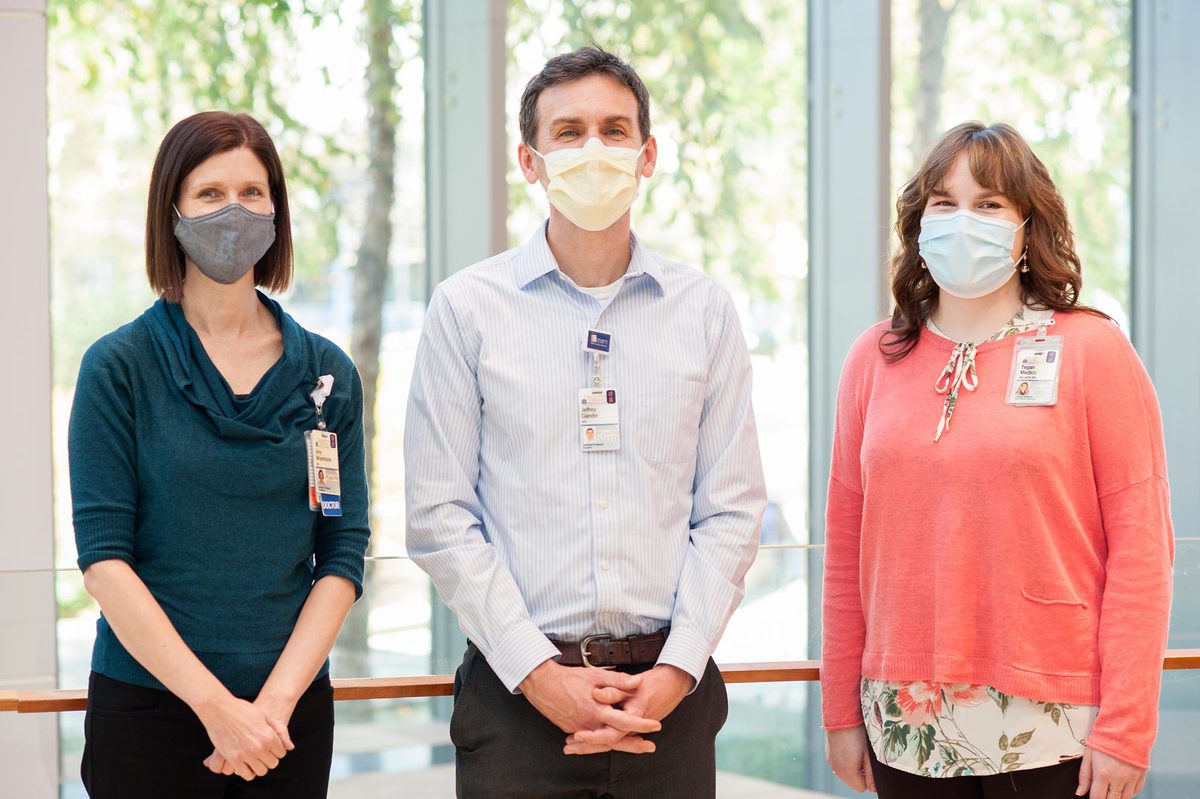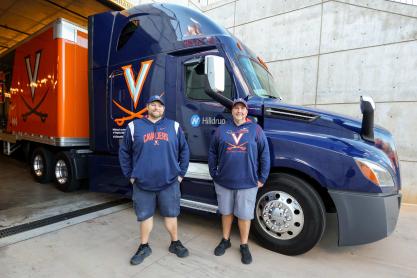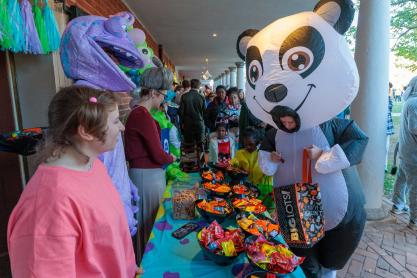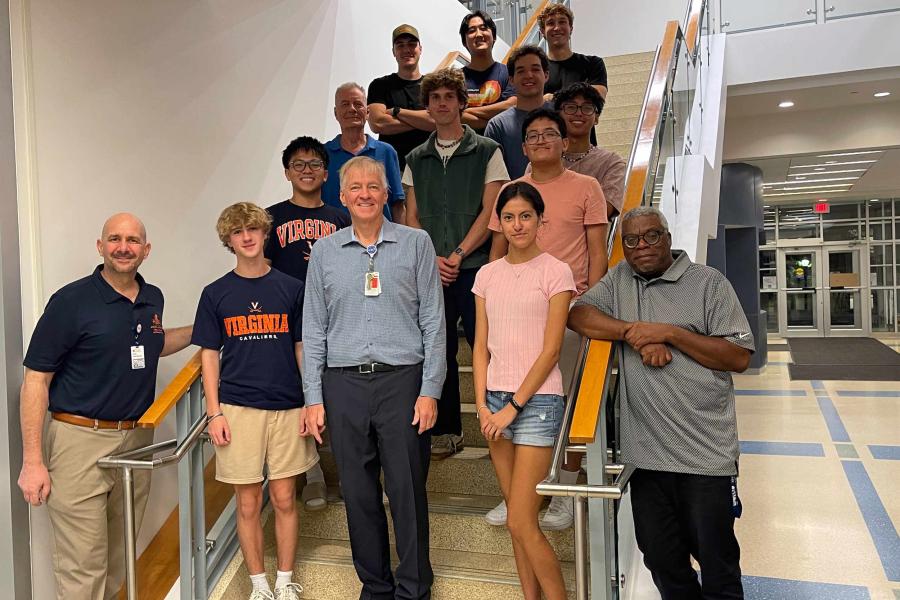The question, “What are you going to do in your community?” had been swirling in Dr. Jeffrey Gander’s mind ever since attending a pediatric conference more than two years ago.
During the COVID-19 pandemic, the answer came to him.
In November, the pediatric surgeon spearheaded the launch of a food insecurity project, which partners with Local Food Hub’s Fresh Farmacy to bring regular deliveries of fresh produce to pediatric patients and in-need families.
“All of us are in a profession to help people and care for people – a healing profession,” Gander said. “We owe it to our patients as part of our care for them to make sure that they have nutritious food. That may be even more powerful than some of their medications. Think about this fresh, healthy food as a way to treat their diseases.”

Dr. Jeffrey Gander, Dr. Amy Wrentmore, left, and pediatric nutritionist Tegan Medico, right, hope to expand the program to every family throughout the medical center who cannot afford fresh healthy food. (Photo by Kay Taylor)
UVA Today caught up with Gander and Tegan Medico, a pediatric nutritionist at UVA Health, to see how the program has been going.
Q. Dr. Gander, can you tell us about the “aha” moment you had at the conference in which you realized you needed to launch something like this for the community?
A. I had attended a conference at the American Academy of Pediatrics in 2018 and listened to several speakers talk about how physicians can have an impact on your community. One particular speaker was Adam Foss, an advocate for criminal justice reform, who really stood out to me. I was fortunate to attend a symposium led by him about six months later where he challenged everyone to find a problem in your community, find like-minded individuals who are working on it and work together.
I started to learn about the almost 20% incidence of food insecurity in Charlottesville, and in particular how people had little access to fresh healthy food, given that it was so expensive.
At the beginning of COVID, I volunteered to deliver meals to students in an underserved community in Charlottesville through a not-for-profit called Cultivate Charlottesville. It was through them that I learned about a partner not-for-profit called Local Food Hub that was partnering with farmers in Virginia to bring healthy food to people who desperately needed it with their Fresh Farmacy program.
Q. Can you give us a snapshot of what childhood obesity looks like in this country and also here in Charlottesville? How big of a problem is it?
JG: For childhood obesity, it is estimated to be 18% in the Blue Ridge Health District. I do see a fair number of obese teens in my surgery clinic. In speaking to some of them, they often talk about most of their nutrition is from the school lunches, which are not always healthy.
TM: Childhood obesity rates in the United States have been rising in a relatively consistent pattern over the past few decades. Most recent data shows that 18.5% of children ages 2 to 19 years met the clinical definition of obesity, which is based on body mass index at the 95th percentile or higher. In Virginia, the overall childhood obesity rate is slightly lower, at 13% for 10- to 17-year-olds as of 2018-19, based on data from the National Survey of Children’s Health.
When you break down this BMI data by family income, there is a clear relationship; the lower the family income, the higher the childhood obesity rate.
Q. How does your program work?
JG: We are identifying families who are food insecure through our Battle Building Pediatrics Clinic. One of our social workers, Lashanna Hicks, has a list of families that have responded “yes” to a two-question screening tool. We are hoping to expand this questionnaire to every family that has a clinic visit.
After the families are identified, they are asked if they would be willing to receive fresh food delivery to their house every other week. At that point, we contact Local Food Hub, and they work with their farmers and deliver a bag of produce, typically eight different foods.
Q. How has the program been going? What have been your takeaways so far? Does it feel gratifying to be helping the community like this?
JG: So far, so good with the program. We have seven families that we have been delivering to. We initially were going to start in the spring, but when we recognized the urgent need, we started right away.
TM: It has been remarkably smooth sailing. Charlottesville’s Local Food Hub deserves much credit here. We just gave them names and addresses, and they took care of the rest.
In fact, one of my biggest takeaways from the project thus far has been how easy it was to do something real, particularly by way of partnerships. While it might be somewhat new to UVA Children’s to focus on food insecurity broadly, it’s not new to many local organizations who are already doing this important work. They know that it starts on the ground.
As a single clinician or a single citizen, it’s easy to feel overwhelmed by a big, complex, societal-level problem like food justice. We can fall into the trap of asking, “How can we solve it all, for everyone?” and overlook the validity of starting small, with our own neighbors. While the scope may be small, it is still significant.
One of my biggest takeaways from the project thus far has been how easy it was to do something real, particularly by way of partnerships. While it might be somewhat new to UVA Children’s to focus on food insecurity broadly, it’s not new to many local organizations who are already doing this important work. They know that it starts on the ground.
- Tegan Medico
Pediatric nutritionist at UVA Health
Q. And this has really been a team effort in the truest sense?
JG: We have a big group working on this. Dr. Amy Wrentmore is a pediatrician and has been advocating for her colleagues to identify families, as well as counseling her own patients on what services that there are to help them. Tegan and Olivia Obertello are both pediatric nutritionists and have been instrumental in deciding on what metrics we can use to make sure our program is having its desired effect. We eventually will be collecting blood pressures and weights.
TM: Working with Dr. Gander has been an honor. He’s clearly passionate about food insecurity among children, and he made so much happen in such a short amount of time by asking the right questions of the right people. And while he’s been the primary energy and momentum in getting this project off the ground, he’s remarkably humble and gracious.
Q. What are the long-term goals for the program?
JG. Long term, we would love to expand this to every family throughout the medical center who cannot afford fresh healthy food. We are starting in Charlottesville, but as this program expands, would love to use it in other counties in the area.
TM: We want the program to expand to reach more families and for the partnership with the Local Food Hub to be sustainable. That will require ongoing funding and probably some justification that a program like this not only is the right thing to do, but also supports the health and well-being of our patients. We hope to demonstrate as much.
We also recognize that the problem of food insecurity is much larger than we are capturing, so we are brainstorming about how to broaden screening efforts and ensure we don’t overburden community partners’ capacity.










